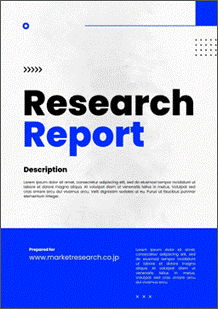 | • レポートコード:B-MOR-05423 • 出版社/出版日:Mordor Intelligence / 2018年3月 • レポート形態:英文、PDF、108ページ • 納品方法:Eメール(受注後2営業日) • 産業分類:Healthcare |
| Single User(1名様用) | ¥629,000 (USD4,250) | ▷ お問い合わせ |
| Team User(7名様用) | ¥666,000 (USD4,500) | ▷ お問い合わせ |
| Corporate User | ¥1,295,000 (USD8,750) | ▷ お問い合わせ |
• お支払方法:銀行振込(納品後、ご請求書送付)
レポート概要
| 本資料は、ウィルスベクターおよびプラスミドDNA製造の世界市場について調べ、ウィルスベクターおよびプラスミドDNA製造の世界規模、市場動向、市場環境、製品タイプ別分析、用途別分析、アメリカ市場規模、ヨーロッパ市場規模、アジア市場規模、日本市場規模、中国市場規模、企業の競争環境、関連企業情報などをまとめた調査レポートです。 ・イントロダクション ・エグゼクティブサマリー ・ウィルスベクターおよびプラスミドDNA製造の世界市場インサイト ・ウィルスベクターおよびプラスミドDNA製造の世界市場環境 ・ウィルスベクターおよびプラスミドDNA製造の世界市場動向 ・ウィルスベクターおよびプラスミドDNA製造の世界市場規模 ・ウィルスベクターおよびプラスミドDNA製造の世界市場規模:製品タイプ別 ・ウィルスベクターおよびプラスミドDNA製造の世界市場規模:用途別 ・ウィルスベクターおよびプラスミドDNA製造の世界市場:地域別市場規模・分析 ・ウィルスベクターおよびプラスミドDNA製造の北米市場規模・予測 ・ウィルスベクターおよびプラスミドDNA製造のアメリカ市場規模・予測 ・ウィルスベクターおよびプラスミドDNA製造のヨーロッパ市場規模・予測 ・ウィルスベクターおよびプラスミドDNA製造のアジア市場規模・予測 ・ウィルスベクターおよびプラスミドDNA製造の日本市場規模・予測 ・ウィルスベクターおよびプラスミドDNA製造の中国市場規模・予測 ・ウィルスベクターおよびプラスミドDNA製造のインド市場規模・予測 ・ウィルスベクターおよびプラスミドDNA製造の韓国市場規模・予測 ・関連企業情報・競争状況 |
Viral vectors and plasmid DNA are products of gene therapy, which are used for the treatment of a large number of diseases. The advantages of gene vaccines and gene therapy over conventional vaccines and therapies include the ability to induce a wider range of immune response types. The global viral vector and plasmid DNA manufacturing market is expected to register a CAGR of 19.5% during the forecast period (2018 – 2023).
Increase in the Number of Clinical Studies
There are a number of clinical studies being conducted on viral vectors and plasmid DNA manufacturing that have emphasized the potential of gene therapy, to address important medical needs, and initiated a surge of investments in drug development and commercialization of these therapies. Genetic markers are associated with many complex diseases, and it is the need of the hour to explore, how genetic information, in conjunction with clinical information, can be used in the design of prevention trials, so that the results can be used in gene therapy product manufacturing. This increase in the number of clinical studies is driving the market.
Technological advancements to mitigate challenges posed by conventional methods of vector production and growing number of gene therapy candidates, coupled with their rapid progression through the various phases of clinical developments, are some of the other factors contributing to the growth of the market.
High Cost of Gene Therapies
The extent of the potential of gene therapy to combat genetic disorders that are beyond conventional cure is unparalleled. The support afforded by patient organizations to gene therapy is significant, and the field is indebted to the thousands of patient volunteers, who have taken part in clinical trials over decades. But, the actual problem is whether gene therapies are accessible and affordable to the patients or not. To date, companies have sought extraordinarily high prices for gene therapy products that reach the market. The readiness and ability of healthcare systems to afford these products will determine whether or not the potential of gene therapies will be fully realized. It is essential to question whether the prices sought by companies are truly justified. The high cost of the gene therapies is hampering the growth of the market.
Additionally, increase in regulatory scrutiny and challenges in viral vector-manufacturing capacity, are also restraining the growth for viral vector and plasmid DNA manufacturing market, across the world.
Asia-Pacific to be a Lucrative Market
The global viral vector and plasmid DNA manufacturing market is segmented by product type, application, and geography. By geography, it is segmented into North America, Europe, Asia-Pacific, the Middle East & Africa, and South America.
Asia-Pacific possesses high market potential, owing to the increase in awareness about vector products, and rise in the viral and non-viral vector applications. This region is anticipated to experience fast-paced growth, in terms of development and use of viral vector and plasmid DNA.
Major players: FUJIFILM DIOSYNTH BIOTECHNOLOGIES, SANOFI, SPARK THERAPEUTICS, UNIQURE, MASSBIOLOGICS, FINVECTOR, BRAMMER BIO, CELL AND GENE THERAPY CATAPULT, AND COBRA BIOLOGICS, amongst others.
Reasons to Purchase The Report
• Market analysis for the global viral vector and plasmid DNA manufacturing market, with region-specific assessments and competition analysis on a global and regional scale
• Analyze various perspectives of the industry, with the help of Porter’s five forces analysis
• The treatment type that is expected to dominate the market
• Regions that are expected to witness the fastest growth during, the forecast period
• Identify the latest developments, market shares, and strategies employed by the major market players
• 3 month analyst support, along with the market estimate sheet (in Excel)
Customization of the Report
• This report can be customized to meet your requirements. Please connect with our representative, who will ensure you get a report that suits your needs.
レポート目次1. Introduction
1.1 Market Definition
2. Research Methodology
3. Executive Summary
4. Key Inferences
5. Market Overview
5.1 Current Market Scenario
5.2 Porter’s Five Forces Analysis
5.2.1 Bargaining Power of Suppliers
5.2.2 Bargaining Power of Consumers
5.2.3 Threat of New Entrants
5.2.4 Threat of Substitute Products and Services
5.2.5 Competitive Rivalry within the Industry
6. Drivers, Restraints, Opportunities and Challenges Analysis (DROC)
6.1 Market Drivers
6.1.1 Technological Advancements to Mitigate Challenges Posed by Conventional Methods of Vector Production
6.1.2 Increase in the Number of Clinical Studies
6.1.3 Growing Number of Gene Therapy Candidates Coupled with their Rapid Progression Through the Various Phases of Clinical Development
6.2 Market Restraints
6.2.1 Increase in Regulatory Scrutiny
6.2.2 High Cost of Gene Therapies
6.2.3 Challenges in Viral Vector-manufacturing Capacity
6.3 Opportunities
6.4 Key Challenges
7. Market Segmentation
7.1 By Product Type
7.1.1 Plasmid DNA
7.1.2 Viral Vectors
7.1.3 Non-Viral Vectors
7.2 By Application
7.2.1 Cancer
7.2.2 Inherited Disorder
7.2.3 Viral Infection
7.2.4 Others
7.3 By Geography
7.3.1 North America
7.3.1.1 United States
7.3.1.2 Canada
7.3.1.3 Mexico
7.3.2 Europe
7.3.2.1 France
7.3.2.2 United Kigdom
7.3.2.3 Germany
7.3.2.4 Italy
7.3.2.5 Spain
7.3.2.6 Rest of Europe
7.3.3 Asia-Pacific
7.3.3.1 India
7.3.3.2 China
7.3.3.3 Japan
7.3.3.4 Australia
7.3.3.5 South Korea
7.3.3.6 Rest of APAC
7.3.4 Middle East And Africa
7.3.4.1 GCC
7.3.4.2 South Africa
7.3.4.3 Rest of Middle East & Africa
7.3.5 South America
7.3.5.1 Brazil
7.3.5.2 Argentina
7.3.5.3 Rest of South America
8. Competitive Landscape
8.1 Mergers and Acquisition Analysis
8.2 Agreements, Collaborations, and Partnerships
8.3 New Product Launches
9. Key Players
9.1 Fujifilm Diosynth Biotechnologies
9.2 Sanofi
9.3 Spark Therapeutics
9.4 Uniqure
9.5 Massbiologics
9.6 Finvector
9.7 Brammer Bio
9.8 Cell and Gene Therapy Catapult
9.9 Cobra Biologics
9.10 Others
10. Future of the Market